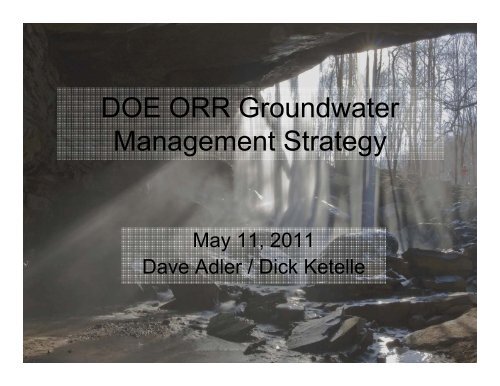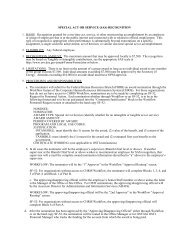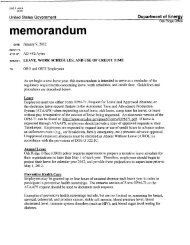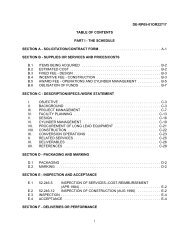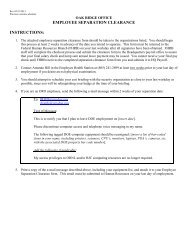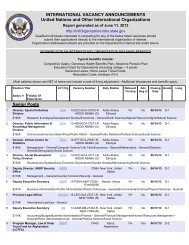DOE ORR Groundwater Management Strategy - DOE Oak Ridge ...
DOE ORR Groundwater Management Strategy - DOE Oak Ridge ...
DOE ORR Groundwater Management Strategy - DOE Oak Ridge ...
You also want an ePaper? Increase the reach of your titles
YUMPU automatically turns print PDFs into web optimized ePapers that Google loves.
<strong>DOE</strong> <strong>ORR</strong> <strong>Groundwater</strong><br />
<strong>Management</strong> <strong>Strategy</strong><br />
May 11, 2011<br />
Dave Adler / Dick Ketelle
<strong>ORR</strong> Site Geology and Areas of<br />
<strong>Groundwater</strong> Contamination<br />
2
<strong>DOE</strong> <strong>Groundwater</strong> Protection Priorities<br />
• Offsite:<br />
– Protect human health, and private and public water<br />
supplies.<br />
• Onsite:<br />
– Use early actions to contain/treat plumes as needed<br />
to meet CERCLA decision goals for groundwater<br />
discharging to surface water.<br />
– Use source controls to minimize additional<br />
contributions to plumes.<br />
3
Evolution of Decision Strategies for<br />
<strong>Groundwater</strong> <strong>Management</strong><br />
• <strong>Oak</strong> <strong>Ridge</strong> Reservation <strong>Groundwater</strong> <strong>Strategy</strong>,<br />
2004 (<strong>DOE</strong>/OR/01-2069&D2)<br />
– Watershed scales Record of Decision <strong>Strategy</strong><br />
– <strong>ORR</strong> <strong>Groundwater</strong> <strong>Strategy</strong><br />
– Area-Specific Interim Decisions/Actions<br />
– Final <strong>Groundwater</strong> Decisions<br />
4
<strong>Groundwater</strong> Remediation Goals<br />
5
<strong>ORR</strong> <strong>Groundwater</strong> Decision Status<br />
• All existing groundwater decisions have been early<br />
actions or are interim decisions<br />
– Y-12 East End VOC Plume pump and treat to mitigate offsite<br />
carbon tetrachloride plume in Union Valley (containment<br />
pumping)<br />
– ORNL Core Hole 8 Plume collection and treatment to mitigate<br />
90<br />
Sr and uranium discharge to First Creek / White <strong>Oak</strong> Creek<br />
– ETTP shallow groundwater collection and treatment for VOCs<br />
• At ETTP the current work on Zone 1 and Zone 2<br />
groundwater is to support final decisions since final<br />
cleanup of sources is under way.<br />
• Final decisions for groundwater at ORNL and Y-12 await<br />
completion of source actions.<br />
6
Status of <strong>Groundwater</strong> <strong>Management</strong> Efforts<br />
by Watershed<br />
7
ORNL<br />
Summary of Past CERCLA<br />
<strong>Groundwater</strong> In Situ Actions<br />
1995 -- SWSA 4<br />
trench grouting on the<br />
road to reduce 90 Sr<br />
discharges by<br />
eliminating voids in<br />
waste<br />
Reduced 90 Sr discharges by ~15%<br />
within 2 years post action.<br />
Supplanted by SWSA 4 cap and<br />
downgradient collection trench.<br />
8
Summary of Past CERCLA<br />
<strong>Groundwater</strong> In Situ Actions<br />
Y-12<br />
2002 -- S-3 Ponds Pathways 1<br />
& 2 in-situ iron filings to reduce<br />
uranium discharges to Bear<br />
Creek<br />
Operation discontinued 2007 because<br />
of mineral precipitation in treatment<br />
media caused by physicochemical<br />
changes in high dissolved solids plume<br />
water. Systems shut down. Additional<br />
decision on S-3 groundwater discharges<br />
pending.<br />
9
Summary of CERCLA <strong>Groundwater</strong><br />
Ex Situ Actions<br />
– ETTP<br />
1998 -- Mitchell Branch groundwater collection trench to remove TCE<br />
contamination near creek<br />
Operation was discontinued 2004 due to iron/manganese fouling of well<br />
screens and pumps. Awaiting progress in Zone 2 final groundwater<br />
decision.<br />
10
Summary of CERCLA <strong>Groundwater</strong><br />
Ex Situ Actions (Cont’d)<br />
Y-12<br />
1999 -- East End VOC plume containment<br />
pump and treatment to reduce offsite<br />
carbon tetrachloride migration<br />
Has partially intercepted offsite migration.<br />
Requires periodic air stripper maintenance<br />
and pump/controller replacements.<br />
11
ORNL<br />
Summary of CERCLA <strong>Groundwater</strong><br />
Ex Situ Actions (Cont’d)<br />
• 1995 -- Seep C gravity flow through<br />
zeolite columns for 90 Sr removal<br />
• Failed because of iron fouling.<br />
Supplanted by SWSA 5 cap + more<br />
robust seepage capture which works<br />
well.<br />
• 1995 -- Seep D collection with forced<br />
pumping through zeolite column for<br />
90 Sr removal<br />
• Worked well. Collected water now<br />
combined with other MV groundwater<br />
treated at ORNL Wastewater<br />
Treatment Facility in Bethel Valley. 12
Lessons Learned to Date<br />
• Mixed success with groundwater projects to date.<br />
• Plume waters typically contain elevated dissolved solids<br />
content.<br />
• Chemical disequilibrium near / in treatment media<br />
causes precipitation of mineral phases that defeats in<br />
situ and ex situ gravity flow systems.<br />
• Forced delivery (pumped) through ex situ media can<br />
work.<br />
• Containment pumping to capture plumes with ex situ<br />
treatment is a fairly reliable short term measure but<br />
requires mechanical system maintenance and longevity.<br />
13
Ongoing CERCLA Treatability Tests<br />
Bethel Valley 7000 Area TCE Plume Biostimulation (Bethel Valley ROD<br />
action)<br />
• Principle<br />
• Native microbes capable of full degradation of TCE to non-hazardous<br />
compounds<br />
• System lacks sufficient electron donors for optimal microbial processes<br />
and needs to be more reductive<br />
• Process<br />
• Hydrogen Releasing Compound ® and Emulsified vegetable oil injected<br />
into 4 wells to create a test treatment zone<br />
• Monitoring for 1 year to measure effectiveness of method in field scale<br />
application<br />
• Expectation<br />
• Recommendation of approach to scaling up to treat more of the plume<br />
will be included in treatability study report<br />
• Challenges<br />
• Delivery of chemical amendments is difficult because of the<br />
heterogeneous fractured bedrock<br />
• Injected amendments tend to move vertically to the water table and<br />
break out in storm drains discharging to surface water bodies<br />
14
Biostimulation<br />
Mix tanks and injection manifold<br />
15
Ongoing CERCLA Treatability Tests<br />
ETTP K-1401 DNAPL Treatability Test – Moving toward final decisions<br />
• Principle<br />
• DNAPL is present in weathered bedrock and extends into fractures in<br />
underlying competent rock<br />
• Low solubility and diffusion into matrix rock material provides longterm<br />
source for dissolved groundwater contamination<br />
• Process<br />
• Characterization and modeling in process in preparation for use of in<br />
situ thermal technology to remove DNAPL from weathered bedrock<br />
zone<br />
• Expectation<br />
• Thermal treatment is expected to remove >90% of DNAPL from<br />
weathered rock source zone<br />
• Challenges<br />
• The technology has not yet been attempted at <strong>Oak</strong> <strong>Ridge</strong><br />
• Some residual will remain posing the likelihood of contaminant rebound<br />
following treatment<br />
• Cost-benefit of treatment vs alternative decision options<br />
16
DNAPL Investigation<br />
Core Drilling<br />
Healed and re-weathered<br />
fracture<br />
DNAPL stains on<br />
FLUTe ® sleeve<br />
17
Summary and Path Forward<br />
• <strong>DOE</strong>-EM has focused significant resources on understanding and<br />
solving groundwater contamination challenges on the <strong>Oak</strong> <strong>Ridge</strong><br />
Reservation.<br />
• Primary focus to date has been on minimizing contamination<br />
impacts on surface water systems consistent with ROD goals and<br />
protection of off-site groundwater resources.<br />
• Engineered systems, including extensive source controls, are in<br />
place to serve these objectives—some have been more successful<br />
than others.<br />
• <strong>DOE</strong> wants to take advantage of technical advances being made in<br />
the industry of groundwater remediation.<br />
• Pilot tests are underway at select locations.<br />
• More work remains to be done. Remaining challenges are complex<br />
and some may be intractable.<br />
• Collaborative planning efforts are scheduled with TDEC/EPA to<br />
scope, schedule, and implement additional measures in Melton<br />
Valley, Bear Creek Valley, and Bethel Valley.<br />
18


